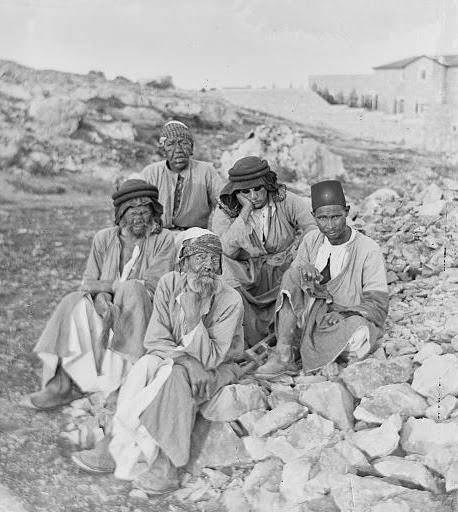
Our original caption:"Lepers, presumably in Jerusalem, (Library of Congress, circa 1900)"
Then we received a note from reader Rivka Regev:I saw the feature you did on "Lepers" of Jerusalem. It was excellent. I have only 2 small comments:
We asked Rivka how she had such expertise on the Hansen hospital. When she explained her father was the in-house physician at the hospital for decades, we appealed to her for additional photos and an article to accompany them. We thank her for the following feature and encourage readers to view her Internet site http://ganneimarpeh.brinkster.net/page33.html
A Riddle Solved at the Historic Hansen Hospital in Jerusalem
By Rivka Regev
Dr. Moshe Goldgraber, the author's father, in front of Hansen Hospital, 2002 (Photo courtesy of the author and Michel Horton)
Dr. Moshe Beer Goldgraber 1913-2007, was born in Zamosc, Poland, studied medicine in Padova, Italy, took his final exam in August 1939, went straight to a shipyard, and got on a freight ship to Palestine. Two weeks later Germany took over Poland. He lost his whole family to the Nazis.
One day at the end of 1964 he went to hear a lecture at Hansen [“Lepers”] Hospital in Jerusalem. Dr. Goldgraber became involved in research and soon became the attending on-call physician (a specialist in internal medicine, among other specialties) at Hansen Hospital from 1965 until the last patients left in 2000.
The hospital's Jesus Hilfe nursery (circa 1907, from the author's collection)
Beginning in 2003, I led a volunteer project to rehabilitate and restore the historic gardens of HansenHospital and Gardens in Jerusalem.
Mule drawn pump at the Hospital (1912, from the author's collection)
But to our surprise the far side of the structure in the old photo turned out to be open. We continued to dig (northward to the farther part of the old photo, towards the cistern) and eventually reached the terrace wall. The old photo actually shows three wooden boards that are clearly visible that covered up the eighth side of the hexagon suggesting how the mule could safely walk over the channel.The volunteers and their discovery (courtesy of the author and Michael Horton )
